IDEX Online Research: Jewelry Price Inflation Abating in U.S. Market
August 23, 12
(IDEX Online) – Retail prices for jewelry in the
Further, wholesale jewelry price inflation continues to moderate. This is the third consecutive month that wholesale price increases have been in the single digit range, after posting double-digit increases for almost every month during the past two years.
Inflation pressures for finished jewelry – both at the wholesale level and at the retail level – have abated due to the lack of price inflation of major components of jewelry including polished diamonds, gold, platinum and silver.
Further, retail price deflation of jewelry is also tied to consumer demand, which has weakened in recent months. Retail sales of jewelry have been tepid since the beginning of 2012, a trend that is likely to continue as long as consumers’ uncertainty levels are high.
The current climate of uncertainty among consumers is being driven by the upcoming presidential election, a faltering economy, the lack of job security, a yo-yo stock market and a weak housing market. When consumers are uncertain, they tighten their purse strings.
Jewelry Wholesale Prices Show Modest Gain in July
In July, the Jewelry Producer Price Index (JPPI) stood at 215.5, down from June’s 215.8. A year ago, the JPPI stood at 204.0. Here’s what this data means:
· Wholesale jewelry prices softened slightly by 0.1 percent on a month-to-month comparison basis. As the graph below illustrates, there has been little jewelry price inflation on a monthly basis since the beginning of 2012; prices have been relatively stable.
· Wholesale jewelry prices rose by about 5.6 percent on a year-to-year comparison basis. This inflation rate is down substantially from the double-digit inflation rates in the first quarter of 2012, and it is only the third single-digit inflation rate in almost two years.
· Wholesale jewelry prices were up 10.3 percent for the first seven months of 2012 versus the same period a year ago.
· The graph below summarizes the JPPI over the past two years.
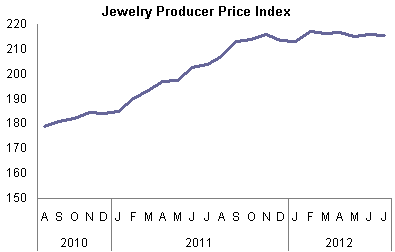 Source: BLS |
Jewelry Retail Prices Down Modestly in July
In July, the Jewelry Consumer Price Index (JCPI) stood at 164.0 versus June’s 166.3. A year ago, the JCPI stood at 167.6. Here’s what this means:
· Retail prices of jewelry declined by 1.4 percent on a month-to-month comparison basis: July versus June.
· Retail jewelry prices dropped by 2.1 percent on a year-to-year comparison basis. Retail prices of jewelry have shown no significant inflation since mid-2011.
· Retail jewelry prices were up by a modest 2.3 percent for the seven months year-to-date 2012 versus the same period a year ago.
· The graph below summarizes the JCPI over the past two years:
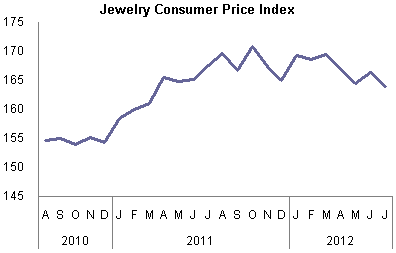 Source: BLS |
Inflation Abates Further in July
After record levels of inflation in 2011, jewelry price inflation in 2012 has finally cooled.
The table below provides detailed inflation / deflation rates for jewelry components as well as inflation rates at various levels of the jewelry distribution channel in the
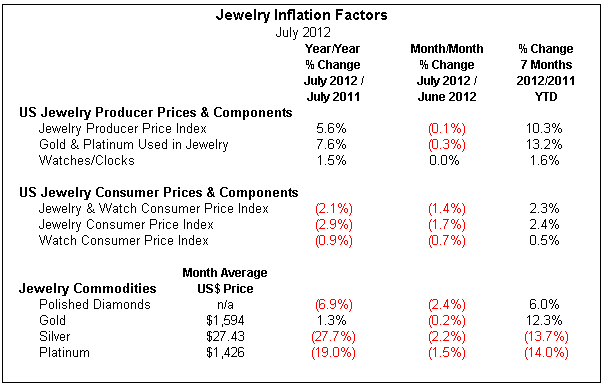 Source: Various Markets |
Jewelry Suppliers’ Price Inflation Moderating
July’s jewelry supplier price inflation rate of 5.6 percent, year-to-year, was significantly less than half of 2011’s inflation rate of 13.9 percent, and it was well below the jewelry supplier inflation rate of 9.3 percent for the full year 2010. In short, it reflects a deflationary trend for wholesale prices in the
After seven months of 2012, jewelry supplier price inflation is up by 10.3 percent, a rate that has been slowing all year.
The graph below summarizes year-over-year jewelry supplier price inflation.
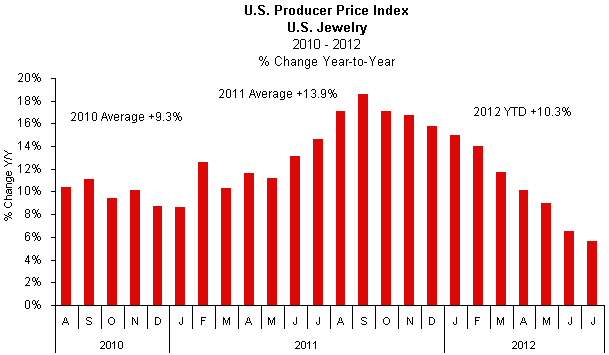 Source: BLS |
Precious Metals & Stone Prices Continue to Moderate
Jewelry suppliers’ prices of precious metals jewelry rose by only 7.6 percent during July 2012 versus the same month a year ago. This was only the second single digit gain since the end of 2010. While this inflation rate was notably above jewelry suppliers’ overall inflation rate for all jewelry and watches of 6.5 percent for the month, it reflects the eighth consecutive month that precious metals price inflation has cooled.
On a month-over-month basis, jewelry suppliers’ prices for precious metal jewelry were down by a miniscule 0.1 percent in July versus June 2012. On an annualized basis, this would suggest that suppliers’ jewelry prices could fall by just over one percent or so.
In June 2012, month-to-month prices indicated a 3-4 percent annual inflation rate, rather than modest deflation, as suggested by July’s numbers. These unrealistic monthly swings illustrate why IDEX Online Research does not put much emphasis on monthly price changes: they simply are not meaningful.
The graph below compares the jewelry supplier inflation rate for precious metals jewelry (gold columns) versus the overall jewelry supplier inflation rate for jewelry (red columns). These comparisons are year-to-year.
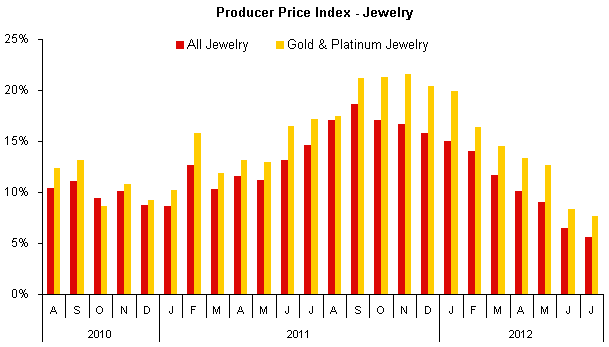 Source: BLS |
Watch Price Inflation Steady for Past Year
Watch prices at the supplier level in July showed a moderate gain of 1.5 percent compared to July 2011. This level of inflation is reminiscent of inflation trends in 2009 and early 2010, when watch prices rose by a low single-digit level at the supplier level. After seven months of 2012, watch prices are up a modest 1.6 percent year-to-date.
On a month-to-month basis, supplier prices of watches were flat, showing neither deflation nor inflation.
In recent months, watch demand and watch sales in the
The graph below shows year-to-year supplier price inflation for watches for the past twenty-four months.
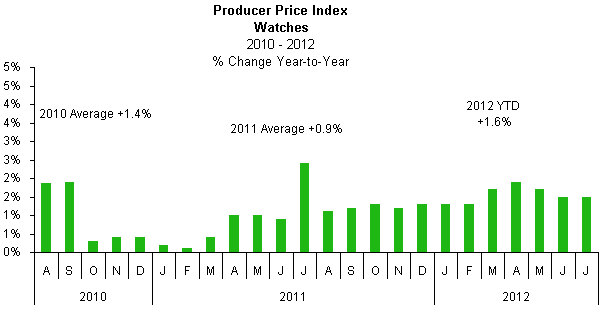 Source: BLS |
Retail: Jewelry and Watch Prices Fall in July
Jewelry and watch retail price inflation has been moderating since the third quarter of 2011. In July, retail jewelry prices fell again – after declining in May and recovering modestly in June. This was only the second deflationary monthly period since the winter of 2009-2010. Year-over-year prices were down by a sharp 2.1 percent at the retail level. Recent muted consumer demand for jewelry, along with moderating price inflation for jewelry commodity materials, is keeping a lid on retail jewelry prices.
On a month-to-month basis, retail jewelry and watch prices in July were down 1.4 percent. Comparing the first seven months of 2012 versus the same seven-month period last year, retail jewelry prices are up by just 2.3 percent.
The graph below summarizes year-to-year retail jewelry price inflation in the
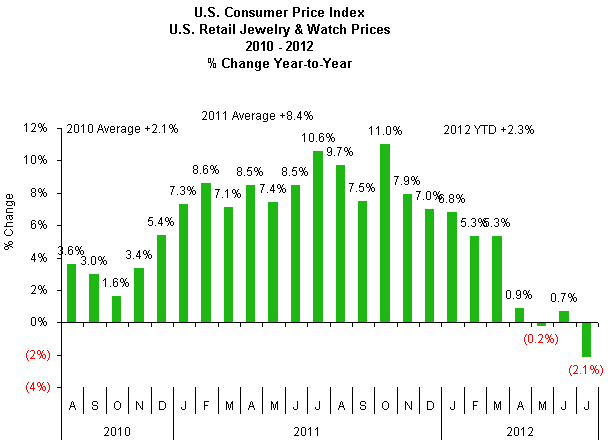 Source: BLS |
Retail Watch Prices Show Moderate Inflation in July
Retail and supplier prices of watches historically have tended to move together, both on a month-to-month basis and on a year-to-year basis, over the past few years. In July, retail watch prices showed modest price deflation while suppliers’ watch prices were flat. Watches tend to carry an inherently lower margin than other jewelry merchandise categories, so this price trend is squeezing retailers’ margins further.
For the month of July, retail watch prices declined by 0.9 percent from July 2011. This is about in line with recent monthly comparisons of year-over year prices. Watch prices also declined by 0.7 percent, when comparing July to June 2012 prices.
Retail Jewelry Prices down More than Retail Watch Prices in July
Retail prices of jewelry, excluding watches, were down 2.9 percent compared to July 2011 prices. This is a dramatic change from prior months, when virtually all year-over-year comparisons were positive.
The graph below compares the inflation rate for jewelry and watches (green bars), jewelry only (red bars), and watches (gold bars).
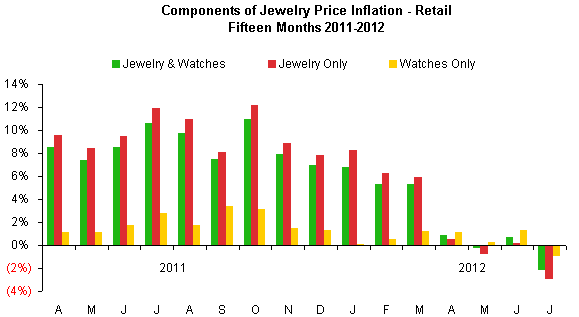 Source: BLS |
Jewelry Inflation Outlook: Moderating Inflation in 2012
Our outlook for jewelry price inflation remains unchanged: jewelry prices are expected to move modestly higher at all levels of the distribution channel throughout 2012. However, the rate of inflation is expected to be well below 2011’s torrid pace, both at the supplier level and at the retail level.
It would be easy to forecast inflation for the jewelry industry if all of the commodities involved in the forecast were used exclusively by the jewelry industry. While that may be the case for polished diamonds, precious metals are used by a number of other industries. Further, gold is an international currency that plays in a financial arena of its own.
· Jewelry Industry Long Term Outlook – Demand from emerging economies such as
· Global Economic Outlook for 2012 – The latest OECD data continues to point to moderate economic growth with a “cautious” outlook in the next 12-18 months. This is a revision from a more positive outlook earlier this year.
· Financial Markets Outlook for 2012 – With continued volatility in the world’s stock markets and uncertain valuations related to stocks, bonds and other hard assets, investors may seek the safe haven that gold offers. Despite predictions by others that gold will hit $2,000 this year, we are not ready to embrace those forecasts. Indeed, after seven months, gold has declined slightly in price.
The bottom line: inflation is headed higher over the longer term, but at a more moderate rate. Jewelry suppliers and retailers should use periods of weakness in commodity prices to add to their inventory.